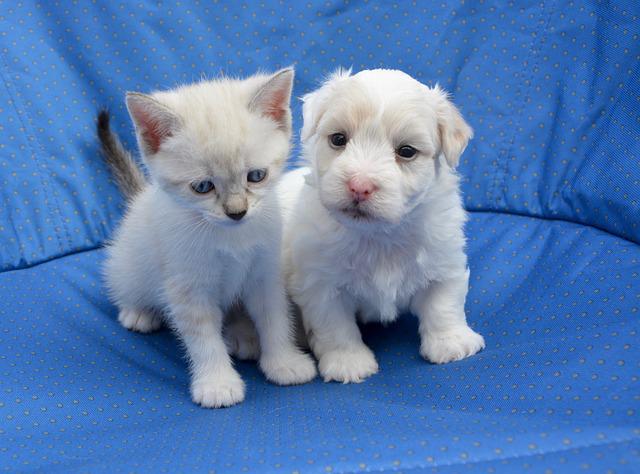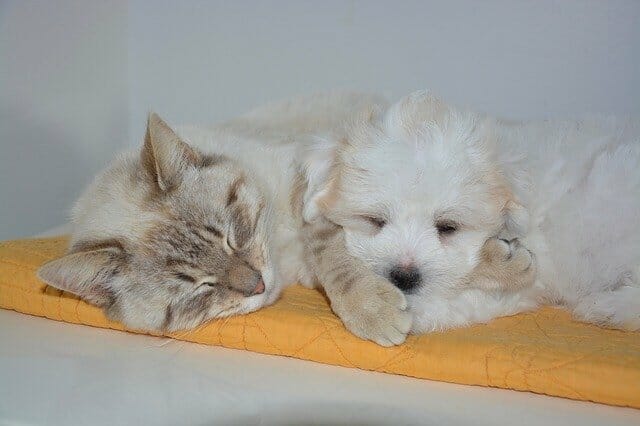How to Get a Cat to Like Dog: Tips to Make Your Cat Like a Dog
Start by gradually adding a dog to your cat’s daily routine. Be watchful of your cat’s body language – if it seems uncomfortable, stop the exercise immediately. If your cat is shy or scared of dogs, start with introductions in a small space and work up there. Be patient – cats take time to adjust to changes in their environment, so be persistent!
Table of Contents
Ways to Make a Cat Like a Dog


Obedience Training
Getting a cat to like a dog can be difficult, but it’s not impossible. The first step is to start obedience training as early as possible. This will help them get used to different noises and people and realize that dogs are not a threat.
You can use various methods to train your cat, but the most important thing is consistency. Ensure you are fair and reasonable when punishing your kitty, and always provide positive reinforcement to make the training process work well for both of you!
Allow Interaction
The best way to get your cat to trust you is by allowing limited interaction under your supervision. Once they’re comfortable with this approach, gradually increase the time they spend around the dog daily. Monitor their behavior and adjust the amount of interaction accordingly so that both of you are happy.
‘Safe Spot’ for Cat
Start by creating a ‘safe spot’ for the cat where the dog cannot enter. For example, try furniture near the open door of your house or in another area where the cat has access, but the dog cannot reach it. Remove any temptation from the vicinity – food, toys, etcetera – and let time work its magic. With patience and a little bit of effort, your cat might start liking dogs!
Swap Scents
If you want your cat to like dogs, you can do a few things. One way is to swap their scents. Cats are scent-oriented, so this can be a helpful way to get them accustomed to the smell of dogs.
Another is to try bathing your dog in some of your cat’s favorite smells – this may help introduce the two species more easily. If all else fails, try using pet treats or toys slightly larger than usual for cats but smaller enough for dogs – this might also encourage interaction between the pets. Happy pet-parenting!
Let Your Cat Go
Cats learn fastest when interacting with people and other animals in direct situations. It will only backfire if you try to force them into getting along with the dog. Instead, let them take their time to get to know each other gradually. The key is patience – cats usually come around once they feel comfortable around the pet. So, give it time, and you’ll soon have a cat that’s friends with your dog!
Show Equal Amounts of Fuss to Both Pets
When bringing home a new pet, you must show equal amounts of fuss to both pets. This will help them get used to each other and establish a hierarchy. Over time, the cat will eventually warm up to the dog, but it may take longer than usual.


If things don’t seem to be working out as planned, consider consulting a veterinarian or animal behaviorist for help. They could help you figure out why the cat is resisting and suggest strategies to get the pet to like the dog. No matter the outcome, patience and much love will get the pet and new family member together in the end!
Separate Them After Their First Meeting
After their first meeting, keeping the cat and dog separate until they’re comfortable with each other is essential. This will prevent any accidents or frustrating behavior from happening later on. If things get too harsh and the cat isn’t getting along with the dog, you can try a few techniques to get them together again.
These might include playing with the dog, using a scratching post for the cat, or simply separating them for a while and bringing them back together. The key is to be consistent and patient; eventually, the cat will warm up to the dog and be best buddies!
Reward Good Behavior
Before you try, make sure to establish good behavior with your cat. This means rewarding them for good behavior with food or toys. If you’re new to pet cats, introduce them slowly and gradually, increasing the number of dog interactions. Consider using a behavior training system to help get your cat used to dogs. Good luck and happy training!
Seeking Help From a Professional
If the cat isn’t getting along with the dog, it might be a good idea to seek professional help. A pet psychologist or animal behaviorist can help you understand why the cat is reacting this way and create a plan for dealing with the problem. They may also be able to put your cat in contact with another similarly-sized dog that the cat can get along well with.
Understanding Types of Aggression in Cats
Fear
In the animal kingdom, aggression is a way of defending one’s turf. Fear aggression is the most common and dangerous of all the different types of aggression that cats can exhibit. When a cat feels threatened, it will react with hostility – this could manifest in various ways, such as hissing, spitting, etc.
Fear-aggressive cats sometimes try to run away or hide from predators instead of fighting back. So if you can identify your cat’s type of aggression early on and get him under control before any clashes happen, that would be an achievement!
Redirected Aggression
Cats can be territorial and react aggressively when seeing another cat as a threat. This type of aggression is called redirected aggression, usually due to fear rather than anger or hatred. Redirected aggression often disappears within a few weeks if you provide your cat with the proper environment and attention.
Territorial Aggression
Cats can become territorial when they feel threatened or infringed upon their territory. This can manifest in different ways, such as vocalization, chasing, and biting. If you have a cat that behaves this way, getting them help from a vet as soon as possible is essential.
Territorial aggression can be reduced by providing your cat with plenty of playtimes and slowly introducing new people/cats into the home – starting with family members close to the cat it perceives as friends.
Aggression Due to Overstimulation


When cats are overstimulated, they may become aggressive. This could happen for various reasons, such as being left alone too much or experiencing too much noise. There are multiple ways to reduce or prevent overstimulation in cats – by playing with them, providing them with toys that keep their minds stimulated, and ensuring they don’t experience high crowds or another sensory overload.
Predatory Aggression
Cats are naturally predatory animals that require a lot of prey to survive. When they’re not getting what they need, cats resort to aggression to meet their needs. This type of behavior usually takes the form of biting and scratching.
Unprovoked Aggression
Unprovoked aggression is a behavior exhibited by cats when they are not provoked. It can be challenging to determine the cause of this aggressive behavior. Still, it is always essential to consult a professional if there seems to be something abnormal going on.
You can do some things to try and help prevent this from happening in the future – for example, keeping your cat litter-free and avoiding sudden changes in routine that might trigger an outburst. However, ultimately it’s best to keep your cat indoors where they will not have as much opportunity to lash out.
